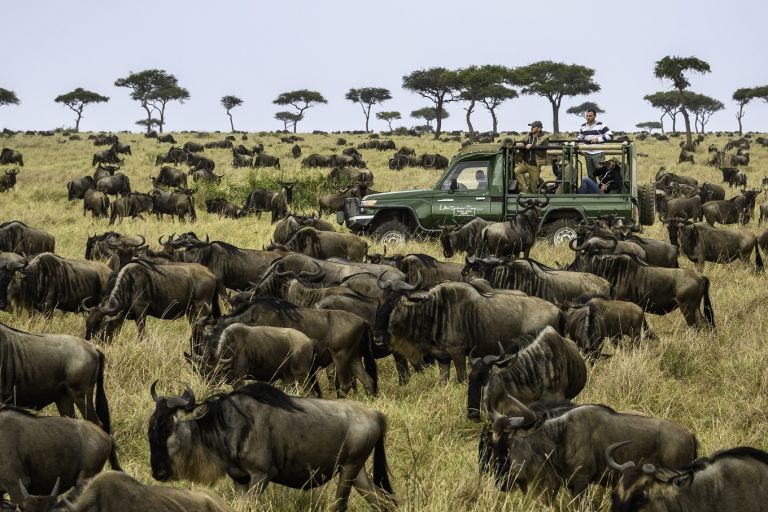This is one of the top wildlife experiences in Africa. The experience occurs between Masai Mara National Park in Kenya and Serengeti National Park in Tanzania.
The numbers of wild animals involved in the migration alone are hard to believe: up to two million animals – wildebeest as well as zebra and gazelles which move clockwise around this enormous ecosystem, driven by ancient instincts to find fresh pasture and drinking water.
The great Serengeti wildebeest migration is the movement of vast numbers of the Serengeti’s wildebeest, accompanied by large numbers of zebra, and some few Grant’s gazelle, Thompson’s gazelle, eland and impala.
The action is done every year when the large number of wildlife move to seek fresh grazing and, it’s now thought, better quality water. The timing of the Serengeti wildebeest migration is totally dependent upon the rainfall patterns each year.
How wildebeest migration is occurs?
The migrating herds of wildlife undergo all manner of challenges and hardships as they move from region to region, and are constantly under attack from predators especially from Africa’s big cats and the notoriously dangerous crocodiles that lie in wait at various streams and river crossing points.
To see the wildebeest migration, you need to plan wisely; the wildebeest migration is a fluid, dynamic affair taking place between Kenya and Tanzania. You can plan to wait in Kenya or Tanzania depending on the advice of your experienced tour operators. Depending on where you will be waiting from at that time, you may see the wildebeest herds giving birth and courting, moving in great dusty columns or funneling across muddy rivers.
There are accommodation in both Masai Mara and the Serengeti to enable you to experience the migration, and nearly all scheduled tours and safaris to either country include excursions into the two conservation areas. For a faultless wildebeest migration safaris you are requested to contact one of our East African experts to help you tailor make your itinerary basing on your interest. Their knowledge and experience of the migration means you’ll be in safe hands to witness this once-in-a-lifetime event.
The short rains begin around early November. A little after this, in late November and December, the herds of the wildebeest migration arrive on the short-grass plains of the Serengeti. These are south and east of Seronera, around Ndutu and include the north of the Ngorongoro Conservation Area. Dispersed across these plains, wildebeest and zebra are everywhere – feeding on the fresh, nutritious grasses. They stay here through January, February and March, with most wildebeest calves born in a short window around February. Gradually they spread west across these plains, then around April they start their great migration north. It should be noted that Wildebeest migration depends on the pasture and water – animals move to the area where there in plenty of pasture and water.
By May the Serengeti’s wildebeest all seem to be moving north, migrating to seek fresh grazing and water. Some of the migration then head due north of Seronera, but most are usually further west. Around June the wildebeest migration is often halted on the south side of the Grumeti River, which has some channels which block or slow their migration north. The wildebeest then congregate there, in the Western Corridor, often building up to a high density before crossing the river. The river here is normally a series of pools and channels, but it’s not continuous – and so whilst they always represent an annual feast for the Grumeti River’s large crocodiles, these aren’t usually quite as spectacular as the crossings of the Mara River, further north.
The wildebeest migration continues moving northwards during July and August, often spreading out across a broad front: some heading through Grumeti Reserve and Ikorongo, others north through the heart of the Serengeti National Park.
September sees the herds spread out across the northern Serengeti, where the Mara River provides the migration with its most serious obstacle. This river gushes through the northern Serengeti from Kenya’s adjacent Maasai Mara Game Reserve.
Watching the frantic herds of the wildebeest migration crossing the Mara River can be very spectacular; there are often scenes of great panic and confusion. It’s common to see herds cross the Mara River north on one day, and then back south a few days later. By October the wildebeest herds are migrating again with more accord: all are heading south, through western Loliondo and the Serengeti National Park’s Lobo area, returning to the green shoots which follow the rains on the short-grass plains of the southern Serengeti in November.












